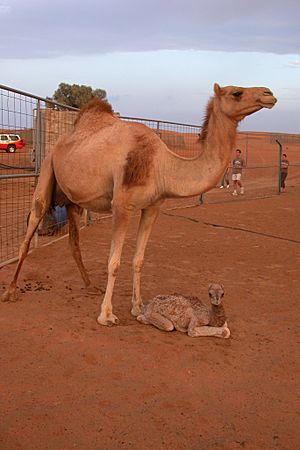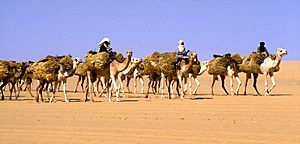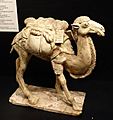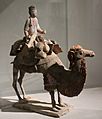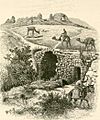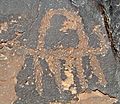Camel facts for kids
Quick facts for kids Camel |
|
|---|---|
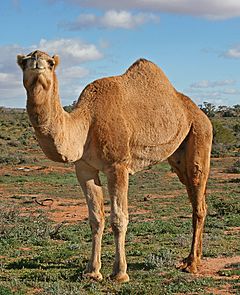 |
|
| Dromedary, Camelus dromedarius | |
| Scientific classification | |
| Kingdom: | |
| Phylum: | |
| Class: | |
| Order: | |
| Family: | |
| Genus: |
Camelus
Linnaeus, 1758
|
Camels are amazing mammals that belong to the Camelidae family. They are part of a group called the Camelus genus. There are three main types of camels alive today. The most well-known are the dromedary (which has one hump) and the Bactrian camel (which has two humps).
The Camelidae family also includes other cool animals. These are often called "New World" camelids. They include the llama, the alpaca, the guanaco, and the vicuña.
The very first known camel was called Protylopus. It lived in North America a very long time ago, about 40 to 50 million years ago. This was during a time called the Eocene period. Protylopus was only about the size of a rabbit. It lived in open woodlands in what is now South Dakota.
Contents
How Camels Live in the Desert
Camels live in deserts, which are very hot and dry places. They have special ways to survive there. Their thick coat of hair keeps them safe from the hot sun during the day. It also keeps them warm when the desert gets cold at night.
Camels have large feet that spread their weight. This helps them walk easily on soft sand without sinking. When they find food and water, camels can eat and drink a lot. They store this energy as fat in their hump. When there isn't much food or water, the camel uses this fat for energy. Its hump then becomes smaller and softer.
Camels are very good at saving water. Their waste has very little water in it. Even the water from their breath goes back into their mouths! They have bushy eyebrows and two sets of eyelashes to keep sand out of their eyes during sandstorms. Their nostrils can close to stop sand from getting in.
A camel also has a long, thin neck. This helps it reach high leaves, like those on palm trees. They have tough, rubbery patches on their belly and knees. These protect their skin when they kneel or sit on the hot sand. These patches grow after a camel is about five years old.
Camels can also change their body temperature. They can let their body temperature go up or down by six degrees Celsius. This helps them stay comfortable in the desert's changing heat. They have thick, rubbery lips to eat dry, prickly plants without getting hurt. A large, hairy tail helps them swat away bugs like mosquitoes and flies.
Camel Life and Habits
Camels usually live in groups. These groups often have one male, several females, and their young, called calves. Camels are animals that walk on their hooves.
Reproduction
A baby camel grows inside its mother for about 9 to 11 months. Usually, only one calf is born at a time. A camel calf can run just a few hours after it is born! Young camels stop drinking their mother's milk when they are about 1 year old.
Diet
When camels live with people in the desert, they are fed grass, grains, wheat, and oats. When camels travel in the desert, finding food can be hard. They might have to eat dried leaves, seeds, and thorny twigs. Their tough mouths mean these prickly plants don't hurt them. If there's no regular food, camels will eat almost anything. They might even eat leather or parts of their owner's tent!
Digestion
Camels are ruminants, which means they chew their food in a special way. They don't chew their food completely before swallowing it the first time. The food goes into the first part of their stomach. Later, this partly chewed food, called cud, comes back up to the camel's mouth. The camel then chews it again. After that, the camel swallows the cud again. It then goes to other parts of the stomach to be fully digested.
Camels and Humans
Humans started taming camels about 5000 years ago. This is called domestication. People use camels for riding and to carry heavy things. Camels also provide meat, milk, and wool.
Today, domesticated camels are used in Africa, Asia, and even Australia. There are only about 900-1000 wild Bactrian Camels left. They live in China, the Tibetan Plateau, and Mongolia. There are no wild dromedaries left in their original homes. However, many dromedaries that escaped from farms now live wild in the outback in Australia. About 700,000 dromedaries live wild there today.
Fun Facts About Camels
- Newborn camels don't have humps. They grow as the camel gets older.
- Some people think camels are smarter than horses.
- Camels sometimes pee on their back legs to help them cool down.
- Camels can live for about 40 to 50 years.
- Female camels are called cows, and males are called bulls.
- The world's largest meal is said to be a roasted stuffed camel! The Bedouin people, who are nomadic Arabs, sometimes make this huge feast for weddings.
- In Abu Dhabi, you can buy a camel milkshake made with camel milk.
- A group of camels traveling together is called a caravan.
- Camel dung (poop) can be used as fuel.
- Camels can carry a lot of weight, from about 375 to 600 pounds (170 to 270 kilograms).
Images for kids
-
Skull of an F1 hybrid camel, Museum of Osteology, Oklahoma
-
A camel carrying supplies, Tang dynasty
-
A man on a camel, Tang dynasty
-
Woman breastfeeding on a camel, Tang dynasty
-
Camel Corps at Magdhaba, Egypt, 23 December 1916, by Harold Septimus Power (1925)
-
A camel caravan of the Bulgarian military during the First Balkan War, 1912
-
A camel calf nursing on camel milk
-
Camel meat pulao, from Pakistan
-
Camels in the Guelta d'Archei, in northeastern Chad
-
Camelops hesternus the last true camel native to North America
-
A camel serving as a draft animal in Pakistan (2009)
-
A camel in a ceremonial procession, its rider playing kettledrums, Mughal Empire (c. 1840)
-
Joseph Sells Grain by Bartholomeus Breenbergh (1655), showing camel with rider at left
-
Vessel in the form of a recumbent camel with jugs, 250 BC – 224 AD, Brooklyn Museum
-
Maru Ragini (Dhola and Maru Riding on a Camel), c. 1750, Brooklyn Museum
-
The Magi Journeying (Les rois mages en voyage)—James Tissot, c. 1886, Brooklyn Museum
-
How the Camel Got His Hump (From Rudyard Kipling's Just So Stories)
See also
 In Spanish: Camello para niños
In Spanish: Camello para niños



